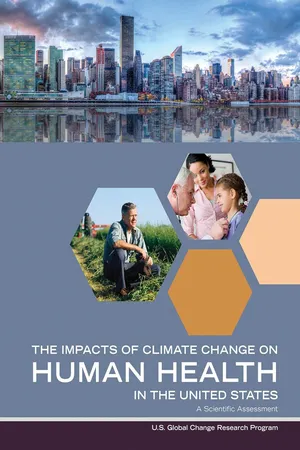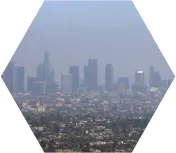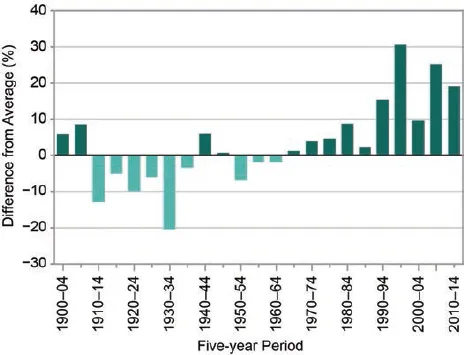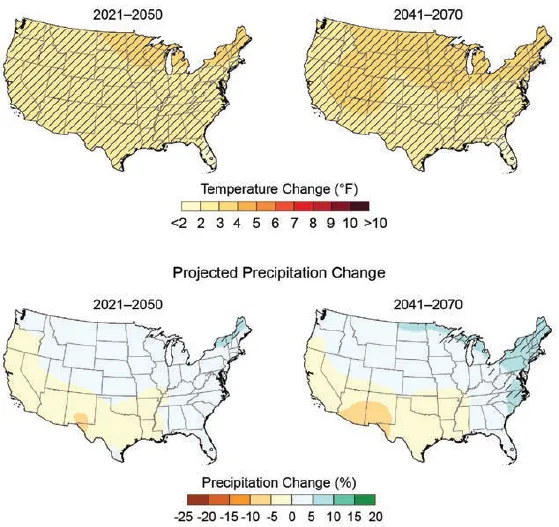
eBook - ePub
Impacts of Climate Change on Human Health in the United States
A Scientific Assessment
- 999 pages
- English
- ePUB (mobile friendly)
- Available on iOS & Android
eBook - ePub
Impacts of Climate Change on Human Health in the United States
A Scientific Assessment
About this book
As global climate change proliferates, so too do the health risks associated with the changing world around us. Called for in the President's Climate Action Plan and put together by experts from eight different Federal agencies, The Impacts of Climate Change on Human Health: A Scientific Assessment is a comprehensive report on these evolving health risks, including:
- Temperature-related death and illness
- Air quality deterioration
- Impacts of extreme events on human health
- Vector-borne diseases
-
Climate impacts on water-related Illness -
Food safety, nutrition, and distribution -
Mental health and well-being -
This report summarizes scientific data in a concise and accessible fashion for the general public, providing executive summaries, key takeaways, and full-color diagrams and charts. Learn what health risks face you and your family as a result of global climate change and start preparing now with The Impacts of Climate Change on Human Health.
Frequently asked questions
Yes, you can cancel anytime from the Subscription tab in your account settings on the Perlego website. Your subscription will stay active until the end of your current billing period. Learn how to cancel your subscription.
No, books cannot be downloaded as external files, such as PDFs, for use outside of Perlego. However, you can download books within the Perlego app for offline reading on mobile or tablet. Learn more here.
Perlego offers two plans: Essential and Complete
- Essential is ideal for learners and professionals who enjoy exploring a wide range of subjects. Access the Essential Library with 800,000+ trusted titles and best-sellers across business, personal growth, and the humanities. Includes unlimited reading time and Standard Read Aloud voice.
- Complete: Perfect for advanced learners and researchers needing full, unrestricted access. Unlock 1.4M+ books across hundreds of subjects, including academic and specialized titles. The Complete Plan also includes advanced features like Premium Read Aloud and Research Assistant.
We are an online textbook subscription service, where you can get access to an entire online library for less than the price of a single book per month. With over 1 million books across 1000+ topics, we’ve got you covered! Learn more here.
Look out for the read-aloud symbol on your next book to see if you can listen to it. The read-aloud tool reads text aloud for you, highlighting the text as it is being read. You can pause it, speed it up and slow it down. Learn more here.
Yes! You can use the Perlego app on both iOS or Android devices to read anytime, anywhere — even offline. Perfect for commutes or when you’re on the go.
Please note we cannot support devices running on iOS 13 and Android 7 or earlier. Learn more about using the app.
Please note we cannot support devices running on iOS 13 and Android 7 or earlier. Learn more about using the app.
Yes, you can access Impacts of Climate Change on Human Health in the United States by US Global Change Research Program in PDF and/or ePUB format, as well as other popular books in Biological Sciences & Global Warming & Climate Change. We have over one million books available in our catalogue for you to explore.
Information
 | 1 | INTRODUCTION: CLIMATE CHANGE AND HUMAN HEALTH |
Lead Authors
John Balbus
National Institutes of Health
Allison Crimmins*
U.S. Environmental Protection Agency
Janet L. Gamble
U.S. Environmental Protection Agency
Contributing Authors
David R. Easterling
National Oceanic and Atmospheric Administration
Kenneth E. Kunkel
Cooperative Institute for Climate and Satellites–North Carolina
Shubhayu Saha
Centers for Disease Control and Prevention
Marcus C. Sarofim
U.S. Environmental Protection Agency
Recommended Citation: Balbus, J., A. Crimmins, J.L. Gamble, D.R. Easterling, K.E. Kunkel, S. Saha, and M.C. Sarofim, 2016: Ch. 1: Introduction: Climate Change and Human Health. The Impacts of Climate Change on Human Health in the United States: A Scientific Assessment. U.S. Global Change Research Program, Washington, DC, 25–42. http://dx.doi.org/10.7930/J0VX0DFW
On the web: health2016.globalchange.gov | *Chapter Coordinator |
1 | INTRODUCTION: CLIMATE CHANGE AND HUMAN HEALTH |

Human health has always been influenced by climate and weather. Changes in climate and climate variability, particularly changes in weather extremes, affect the environment that provides us with clean air, food, water, shelter, and security. Climate change, together with other natural and human-made health stressors, threatens human health and well-being in numerous ways. Some of these health impacts are already being experienced in the United States.
Given that the impacts of climate change are projected to increase over the next century, certain existing health threats will intensify and new health threats may emerge. Connecting our understanding of how climate is changing with an understanding of how those changes may affect human health can inform decisions about mitigating (reducing) the amount of future climate change, suggest priorities for protecting public health, and help identify research needs.
1.1 Our Changing Climate
Observed Climate Change
The fact that the Earth has warmed over the last century is unequivocal. Multiple observations of air and ocean temperatures, sea level, and snow and ice have shown these changes to be unprecedented over decades to millennia. Human influence has been the dominant cause of this observed warming.1 The 2014 U.S. National Climate Assessment (2014 NCA) found that rising temperatures, the resulting increases in the frequency or intensity of some extreme weather events, rising sea levels, and melting snow and ice are already disrupting people’s lives and damaging some sectors of the U.S. economy.2
The concepts of climate and weather are often confused. Weather is the state of the atmosphere at any given time and place. Weather patterns vary greatly from year to year and from region to region. Familiar aspects of weather include temperature, precipitation, clouds, and wind that people experience throughout the course of a day. Severe weather conditions include hurricanes, tornadoes, blizzards, and droughts. Climate is the average weather conditions that persist over multiple decades or longer. While the weather can change in minutes or hours, identifying a change in climate has required observations over a time period of decades to centuries or longer. Climate change encompasses both increases and decreases in temperature as well as shifts in precipitation, changing risks of certain types of severe weather events, and changes to other features of the climate system.
Observed changes in climate and weather differ at local and regional scales (Figure 1). Some climate and weather changes already observed in the United States include:2, 3
• U.S. average temperature has increased by 1.3°F to 1.9°F since record keeping began in 1895; most of this increase has occurred since about 1970. The first decade of the 2000s (2000–2009) was the warmest on record throughout the United States.
Major U.S. Climate Trends

Figure 1: Major U.S. national and regional climate trends. Shaded areas are the U.S. regions defined in the 2014 NCA.2, 4
• Average U.S. precipitation has increased since 1900, but some areas have experienced increases greater than the national average, and some areas have experienced decreases.
• Heavy downpours are increasing nationally, especially over the last three to five decades. The largest increases are in the Midwest and Northeast, where floods have also been increasing. Figure 2 shows how the annual number of heavy downpours, defined as extreme two-day precipitation events, for the contiguous United States has increased, particularly between the 1950s and the 2000s.
• Drought has increased in the West. Over the last decade, the Southwest has experienced the most persistent droughts since record keeping began in 1895.4 Changes in precipitation and runoff, combined with changes in consumption and withdrawal, have reduced surface and groundwater supplies in many areas.
• There have been changes in some other types of extreme weather events over the last several decades. Heat waves have become more frequent and intense, especially in the West. Cold waves have become less frequent and intense across the nation.
Change in Number of Extreme Precipitation Events

Figure 2: Time series of 5-year averages of the number of extreme 2-day duration precipitation events, averaged over the United States from 1900 to 2014. The number is expressed as the percent difference from the average for the entire period. This is based on 726 stations that have precipitation data for at least 90% of the days in the period. An event is considered extreme if the precipitation amount exceeds a threshold for a once-per-year recurrence. (Figure source: adapted from Melillo et al. 2014)2
• The intensity, frequency, and duration of North Atlantic hurricanes, as well as the frequency of the strongest (category 4 and 5) hurricanes, have all increased since the early 1980s. The relative contributions of human and natural causes to these increases remain uncertain.
Projected Climate Change
Projections of future climate conditions are based on results from climate models—sophisticated computer programs that simulate the behavior of the Earth’s climate system. These climate models are used to project how the climate system is expected to change under different possible scenarios. These scenarios describe future changes in atmospheric greenhouse gas concentrations, land use, other human influences on climate, and natural factors. The most recent set of coordinated climate model simulations use a set of scenarios called Representative Concentration Pathways (RCPs), which describe four possible trajectories in greenhouse gas concentrations.1 Actual future greenhouse gas concentrations, and the resulting amount of future climate change, will still largely be determined by choices society makes about emissions.2 The RCPs, and the temperature increases associated with these scenarios, are described in more detail in Appendix 1: Technical Support Document and in the 2014 NCA.3, 5, 6
Some of the projected changes in climate in the United States as described in the 2014 NCA are listed below:2, 3
• Temperatures in the United States are expected to continue to rise. This temperature rise has not been, and will not be, uniform across the country or over time (Figure 3, top panels).
• Increases are also projected for extreme temperature conditions. The temperature of both the hottest day and coldest night of the year are projected to increase (Figure 4, top panels).
• More winter and spring precipitation is projected for the northern United States, and less for the Southwest, over this century (Figure 3, bottom panels).
• Increases in the frequency and intensity of extreme precipitation events are projected for all U.S. areas (Figure 4, bottom panels).
• Short-term (seasonal or shorter) droughts are expected to intensify in most U.S. regions. Longer-term droughts are expected to intensify in large areas of the Southwest, the southern Great Plains, and the Southeast. Trends in reduced surface and groundwater supplies in many areas are expected to continue, increasing the likelihood of water shortages for many uses.
Projected Changes in Temperature and Precipitation by Mid-Century

Figure 3: Projected changes in annual average temperature (top) and precipitation (bottom) for 2021–2050 (left) and 2041–2070 (right) with respect to the average for 1971–2000 for the RCP6.0 scenario. The RCP6.0 pathway projects an average global temperature increase of 5.2°F in 2100 over the 1901–1960 ...
Table of contents
- Cover
- Title Page
- Copyright
- Table of Contents
- About this Report
- Guide to the Report
- List of Contributors
- Executive Summary
- 1. Introduction: Climate Change and Human Health
- 2. Temperature-Related Death and Illness
- 3. Air Quality Impacts
- 4. Impacts of Extreme Events on Human Health
- 5. Vector-Borne Diseases
- 6. Climate Impacts on Water-Related Illness
- 7. Food Safety, Nutrition, and Distribution
- 8. Mental Health and Well-Being
- 9. Populations of Concern
- Appendix 1: Technical Support Document: Modeling Future Climate Impacts on Human Health
- Appendix 2: Process for Literature Review
- Appendix 3: Report Requirements, Development Process, Review, and Approval
- Appendix 4: Documenting Uncertainty: Confidence and Likelihood
- Appendix 5: Glossary and Acronyms